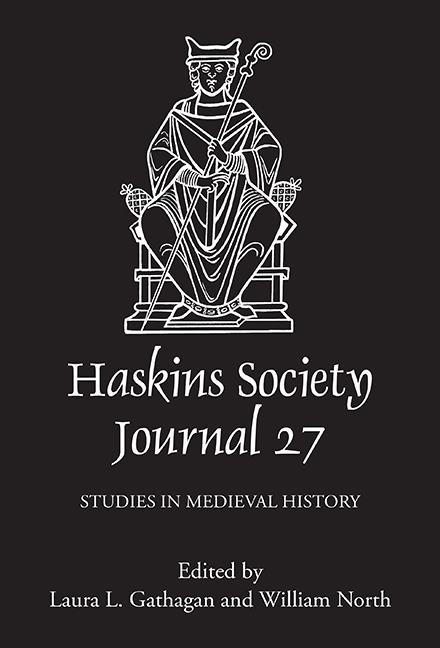Book contents
- Frontmatter
- Contents
- List of Figures
- Editors’ Note
- Abbreviations
- 1 Rural Settlement in Roman Britain and Its Significance for the Early Medieval Period
- 2 Holy Relics, Authority, and Legitimacy in Ottonian Germany and Anglo-Saxon England
- 3 Beyond the Obvious: Ælfric and the Authority of Bede
- 4 Byrhtferth’s Historia Regum and the Transformation of the Alfredian Past
- 5 Geoffrey le Bel of Anjou and Political Inheritance in the Anglo-Norman Realm
- 6 Observations on the Twelfth-century Historia of Alfred of Beverley
- 7 Helena, Constantine, and the Angevin Desire for Jerusalem
- 8 The Revolts of the Embriaco and the Fall of the County of Tripoli
- 9 Jewish Women, Christian Women, and Credit in Thirteenth-Century Catalonia
- 10 Military Entrepreneurs in the Armies of Edward I (1272–1307) of England
5 - Geoffrey le Bel of Anjou and Political Inheritance in the Anglo-Norman Realm
Published online by Cambridge University Press: 07 May 2022
- Frontmatter
- Contents
- List of Figures
- Editors’ Note
- Abbreviations
- 1 Rural Settlement in Roman Britain and Its Significance for the Early Medieval Period
- 2 Holy Relics, Authority, and Legitimacy in Ottonian Germany and Anglo-Saxon England
- 3 Beyond the Obvious: Ælfric and the Authority of Bede
- 4 Byrhtferth’s Historia Regum and the Transformation of the Alfredian Past
- 5 Geoffrey le Bel of Anjou and Political Inheritance in the Anglo-Norman Realm
- 6 Observations on the Twelfth-century Historia of Alfred of Beverley
- 7 Helena, Constantine, and the Angevin Desire for Jerusalem
- 8 The Revolts of the Embriaco and the Fall of the County of Tripoli
- 9 Jewish Women, Christian Women, and Credit in Thirteenth-Century Catalonia
- 10 Military Entrepreneurs in the Armies of Edward I (1272–1307) of England
Summary
The coronation of Henry II as king of England on 7 December 1154 marked the formal conclusion of a nearly twenty-year conflict over the succession of Henry I. While a personal victory for the young king, the supporters of King Stephen were willing to accept his coronation because of a compromise reached the previous year that recognized Henry's right of succession without delegitimizing Stephen's kingship. The parties finalized the terms for peace at Winchester in November 1153. Stephen appointed Henry as his successor and heir ‘by hereditary right’, promising to include Henry ‘in all the affairs of the kingdom’. Henry agreed that Stephen would remain king so long as the magnates and bishops of England swore an oath to recognize his succession peacefully upon Stephen's death. This compromise, which gave Henry uncontested rights to the crown, redefined the legitimacy of his succession and shaped how contemporaries remembered his parents. Edmund King observes that chroniclers began to write about the civil war as a reflection of the conflict between Stephen and Henry, diminishing or denying altogether any authority that Matilda or her husband, Count Geoffrey le Bel of Anjou, had claimed in the Anglo-Norman realm. This tendency can be seen in the Historia Gaufredi, a biography of Count Geoffrey that was written for the court of Henry II by John of Marmoutier, a monk from Touraine. Although Geoffrey had become duke of Normandy, John clarifies that the count of Anjou invaded the duchy ‘so that he could defend the inheritance for his son’. This allowed him to rehabilitate Geoffrey's legacy as the conqueror of Normandy within the context of the political compromises that existed after Henry received the duchy from his father in 1150.
The purpose of this study is to establish how Geoffrey le Bel viewed his rightful place in the Anglo-Norman realm from the beginning of his marriage. It is has been difficult for scholars to evaluate Geoffrey's expectations without viewing him as the precursor to Henry II. Charles Haskins tried to simplify the issue by focusing on the charters and writs produced by Geoffrey's chancellery in Normandy. His explanation about why Geoffrey chose to maintain Norman administrative practices centers on Geoffrey's decision in 1150 to abdicate the ducal title in favor of his son.
- Type
- Chapter
- Information
- The Haskins Society Journal 272015. Studies in Medieval History, pp. 79 - 100Publisher: Boydell & BrewerPrint publication year: 2016



